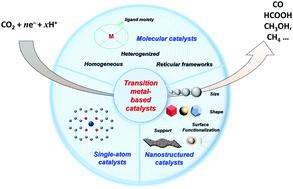当前位置:
X-MOL 学术
›
Chem. Soc. Rev.
›
论文详情
Our official English website, www.x-mol.net, welcomes your
feedback! (Note: you will need to create a separate account there.)
Transition metal-based catalysts for the electrochemical CO2 reduction: from atoms and molecules to nanostructured materials.
Chemical Society Reviews ( IF 40.4 ) Pub Date : 2020-08-25 , DOI: 10.1039/d0cs00835d Federico Franco 1 , Clara Rettenmaier , Hyo Sang Jeon , Beatriz Roldan Cuenya
Chemical Society Reviews ( IF 40.4 ) Pub Date : 2020-08-25 , DOI: 10.1039/d0cs00835d Federico Franco 1 , Clara Rettenmaier , Hyo Sang Jeon , Beatriz Roldan Cuenya
Affiliation

|
The electrochemical reduction of carbon dioxide (CO2) powered by renewable energy is an attractive sustainable approach to mitigate CO2 emissions and to produce fuels or value-added chemicals. In order to tackle the challenges related to selectivity, activity, overpotential and durability, transition metal-based catalysts have been widely investigated in the last decades. In an effort to bridge the gap between the fields of homogeneous and heterogeneous catalysis, this review aims to survey the main strategies explored for the rational design of a wide variety of different metal catalysts, ranging from molecular systems to single-atom and nanostructured catalysts. Transition metal complexes containing heme and non-heme ligands have been selected to discuss the recent advances in the understanding of the structure–function relationship in molecular homogeneous catalysis as well as to summarize the main approaches proposed for the heterogenization or confinement of molecular catalysts on conductive surfaces. The main strategies to minimize catalyst cost are also presented, leading to atomically dispersed molecular-like M–Nx moieties embedded on 2D conducting materials. The superior performances of single-atom catalysts (SACs) and the structural similarity with their molecular analogs, suggest that transition metal catalysts containing well-defined sites may be intrinsically more active and selective towards CO2 conversion than the bulk heterogeneous materials. Finally, design approaches for metal nanoparticles (NPs) based on size, shape, and support tuning are summarized and compared to novel strategies based on the interaction with surface-bonded organic molecules. The studies herein presented show that the basic principles in molecular catalysis and organometallic chemistry can be effectively used to design new efficient and selective heterogeneous catalysts for CO2 reduction.
中文翻译:

用于电化学还原CO2的过渡金属基催化剂:从原子和分子到纳米结构材料。
二氧化碳的电化学还原(CO 2,采用可再生能源)是减轻CO一个有吸引力的可持续的方法2排放并产生燃料或增值化学品。为了应对与选择性,活性,超电势和耐久性有关的挑战,近几十年来,对过渡金属基催化剂进行了广泛的研究。为了弥合均相催化和非均相催化领域之间的差距,本综述旨在调查为合理设计从分子系统到单原子和纳米结构催化剂的各种不同金属催化剂而探索的主要策略。选择了含血红素和非血红素配体的过渡金属配合物,以讨论对分子均相催化中结构与功能关系的理解的最新进展,并总结了在导电性上将分子催化剂异化或限制的主要方法表面。还提出了使催化剂成本最小化的主要策略,从而导致原子分散的分子状M–Nx嵌入2D导电材料上的部分。单原子催化剂(SAC)的优异性能以及与它们的分子类似物的结构相似性表明,含有明确定义位点的过渡金属催化剂可能比块状多相材料本质上更具活性,并且对CO 2转化的选择性更高。最后,总结了基于尺寸,形状和支撑调整的金属纳米颗粒(NPs)设计方法,并将其与基于与表面键合的有机分子相互作用的新颖策略进行了比较。本文提出的研究表明,分子催化和有机金属化学的基本原理可以有效地用于设计用于CO 2还原的新型高效选择性多相催化剂。
更新日期:2020-10-05
中文翻译:

用于电化学还原CO2的过渡金属基催化剂:从原子和分子到纳米结构材料。
二氧化碳的电化学还原(CO 2,采用可再生能源)是减轻CO一个有吸引力的可持续的方法2排放并产生燃料或增值化学品。为了应对与选择性,活性,超电势和耐久性有关的挑战,近几十年来,对过渡金属基催化剂进行了广泛的研究。为了弥合均相催化和非均相催化领域之间的差距,本综述旨在调查为合理设计从分子系统到单原子和纳米结构催化剂的各种不同金属催化剂而探索的主要策略。选择了含血红素和非血红素配体的过渡金属配合物,以讨论对分子均相催化中结构与功能关系的理解的最新进展,并总结了在导电性上将分子催化剂异化或限制的主要方法表面。还提出了使催化剂成本最小化的主要策略,从而导致原子分散的分子状M–Nx嵌入2D导电材料上的部分。单原子催化剂(SAC)的优异性能以及与它们的分子类似物的结构相似性表明,含有明确定义位点的过渡金属催化剂可能比块状多相材料本质上更具活性,并且对CO 2转化的选择性更高。最后,总结了基于尺寸,形状和支撑调整的金属纳米颗粒(NPs)设计方法,并将其与基于与表面键合的有机分子相互作用的新颖策略进行了比较。本文提出的研究表明,分子催化和有机金属化学的基本原理可以有效地用于设计用于CO 2还原的新型高效选择性多相催化剂。











































 京公网安备 11010802027423号
京公网安备 11010802027423号